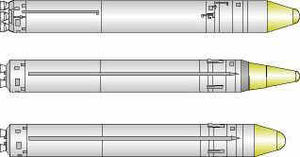The statements, views and opinions expressed in this column are solely those of the author and do not necessarily represent those of this site. This site does not give financial, investment or medical advice.
The Avangard hypersonic glide warhead is the new state of the art reality in long distance nuclear warfare. In the last several days we have learned more about this cutting-edge weapons platform. On 20 March, 2018, both the American site NationalInterest.org and the Russian News Agency TASS released new information regarding the booster vehicle and delivery system for the Avangard warhead.
In the short term, Russia plans to utilize surplus UR-100UTTKh (NATO Codenamed: “SS-19 Stiletto”) as the booster for the hybrid ICBM / intelligent glide vehicle.
In the early 2000s, about 30 UR-100N UTTKh liquid-propellant missiles were delivered from Ukraine for the ‘gas debt,’” a Russian defense industry source told the Moscow-based TASS news agency. “After the disintegration of the USSR, they were kept at warehouses in their unfueled condition, i.e. they were actually new and capable of going on combat duty to serve for several dozen years. A part of these missiles will become the carriers of the first series of hypersonic glide vehicles in the next few years.”
Later, when the Sarmat-28 liquid-fueled ICBM is in full production, these will be placed in service for the Avangard. The Sarmat is a powerful 200-ton missile capable of delivering its warhead payload anywhere on Earth from any direction. It is not precisely an ICBM as much as a FOBS (Fractional Orbiting Bombardment System) because it actually attains Earth orbit. This allows it to approach a target from any direction, where most traditional ICBM’s fly ballistic (gravity driven) trajectories over the North Pole, because this is the shortest route between Russia and the United States’ respective territories.
The Avangard glide vehicle itself is to be outfitted with a single massive thermonuclear warhead with a yield exceeding two megatons of TNT – a yield quite a bit higher than the 500 Kt yields usual warheads presently carry on typical ICBMs.
The Avangard is viewed by National Interest as an “assured retaliatory second strike weapon” designed to fly around missile defenses. This stands as consistent with Russia’s President Vladimir Putin’s statement that Russia will never instigate a nuclear attack unless attacked in the same manner, or with conventional weapons in such as way as to threaten Russia’s existence as a nation.
TASS further reported that there are a total of about 30 SS-19’s that can be outfitted with Avangard. These missiles were returned to Russia by the Ukrainian government in the early 2000’s to help settle a gas debt owed by Ukraine at the time. They have been kept in good condition and remain ready to serve their purpose.
We have provided some specifications data on the SS-19 here below (courtesy Wikipedia.org)
 |
|
| Type | ICBM |
|---|---|
| Service history | |
| In service | 1975–present |
| Used by | Russian Strategic Missile Troops |
| Production history | |
| Designer | NPO Mashinostroyeniya |
| Manufacturer | Khrunichev Machine-Building Plant |
| Specifications | |
| Weight | 105.6 tonnes |
| Length | 27 metres |
| Diameter | 2.5 m |
| Warhead | up to 6, Avangard (hypersonic glide vehicle) on Mod 3 UR-100NUTTKh[1] |
| Blast yield | 400 kt (Mod 3),[2] 5 Mt (Mod 2) |
|
|
|
| Engine | two-stage liquid fuel |
|
Operational
range |
10,000 km |
|
Guidance
system |
inertial |
The statements, views and opinions expressed in this column are solely those of the author and do not necessarily represent those of this site. This site does not give financial, investment or medical advice.

